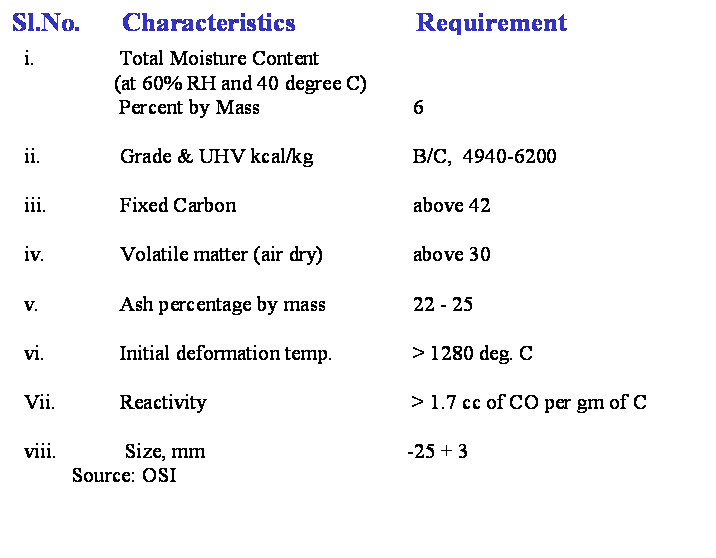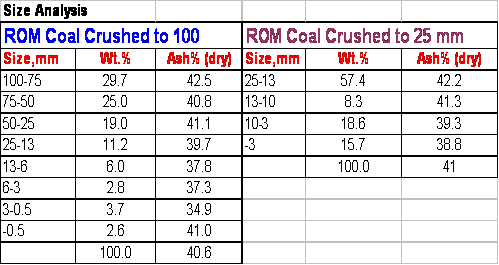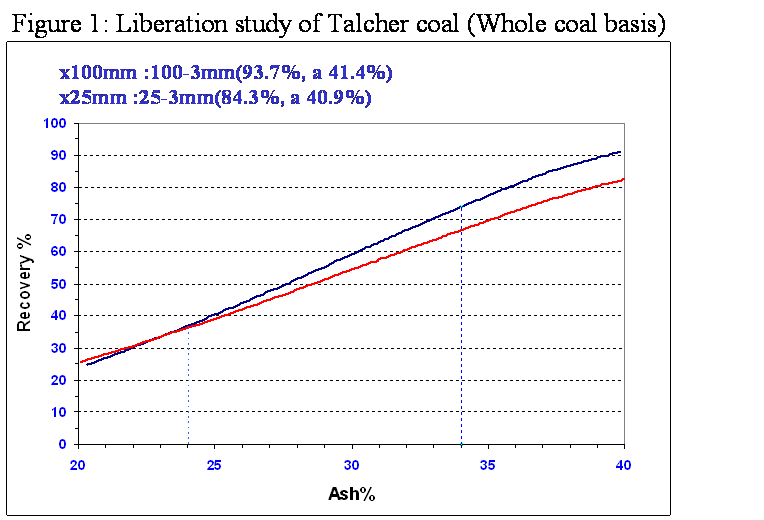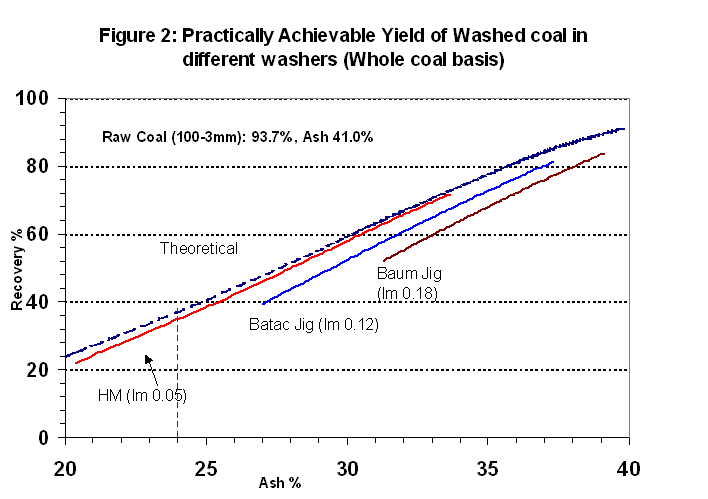kalyansen.com
dr kalyan sen
Prospect of non-coking coal beneficiation in India
Kalyan Sen, Prof Emeritus, Bengal Engineering & Science University Shibpur and
Director, Central Coalfields Ltd, Kolkata.
COAL FOR POWER & STEEL- OPTIONS FOR INDIA. Nov 2008, Kolkata.
Due to Geological reasons, mainly for the “drift origin”, the ash forming mineral matters are so intimately mixed with the coaly substances that their separation by physical means is difficult and results in very little yield of washed coal. At the same time due to the high proportion of “near gravity materials”(ngm) at the cut-point, some times as high as 60-70% of the feed coals, achieving the desired quality and quantity of washed coal is difficult and requires accurate and costly control systems.
It is learned from Statistics that the particles having similar specific gravity (+0.1) may have equal probability (50:50 chance) of being placed in the float or sink of the industrial washer. Thus when the amount of ngm is high, say 60-70%, the yield of cleans can be highly unpredictable and vary both in quantity, and thereby quality, by significant amount. This is the basic reason for difficulties in getting the desired consistent quality of washed coals from high ash non-coking coals of most of the coal fields of India.
It is worth mentioning that again due to geological reasons, the coals are less matured, and thereby, highly reactive and burn rather quickly in the combustion furnaces. At the same time, the amount of Sulphur and other toxic elements like Chloride, Phosphate, etc. are less in coal, which impart to less costly environmental protection systems. Thus, combustion of raw coals was practiced in all major thermal power plants and in some cases the ash of feed coals to power plants was as high as 50%. It may be mentioned that in pulverized fuel furnaces, where these feed coals are ground to fine size like less than 0.072 mm, the combustion efficiency was high and the loss of unburnt carbon was less than 1%, in many cases of newer plants was even less than 0.5%.
However, the loss of sensible heat through the ash handling systems and production of large quantity of fly ash compelled the power plant producers and other consumers of non-coking coals to consider the economical routes for beneficiation of non-coking coals.
The concept of “limiting ash” for any combustion system was forwarded by CFRI to suggest the methodology for determination of the optimum level of washing for any downstream process. It is known that the proportion of the inert matter in any coal particle retards the ease of combustion. It was found in both laboratory Differential Thermal Analyzer s (DTA) and pilot scale Drop Tube Furnaces (DTF) that particles having ash content more than about 55% are not burnt effectively in the conditions prevailing in the PF furnaces (i.e. size of particles up to 0.072 mm and coal being sub-bituminous of rank ro=0.9).
Thus it was proposed to wash the raw coals to get rid of obvious dirt and separate them at high sp. gr of cut, say >2.0 for most of the power coals. It was also realized that the overall ash content of the washed coals from most of the high ash power coals of India would be about 34+2% and thereby the Pollution Control Department insisted that the ash of coals should be restricted to 34% for long distant power houses and sensitive locations.
However, other consumers of non-coking coals desired to have lower levels of limiting particulate ash. Though the laboratory experiments with each and every downstream coal consuming processes could not be completed, it was accepted from experiences that the overall ash content of the feed coals to sponge iron and cements plants should be restricted between 22 and 28%.
Thus it was possible to restrict the overall generation of rejects in washery, ash formation after combustion without sacrificing a lot of process efficiency.
Desired coal quality parameters for power plants are given in the attached table. It is seen that the moisture content of the prepared coals has been restricted from 8 to 12%, so that the handling becomes easy and the formation of dust is also reduced. It is stressed that the desired ash content is maximum 34% on yearly average basis and minimum V.M. content should be 19%. Sulphur and chloride content should be restricted to 0.8 and 0.01%. Thus it can be concluded that the limiting particulate ash should be restricted to 55% and the sp.gr of cut may be about 2.0 to 2.2 for power coals washing.
Coal quality requirements for Power plants
Sl.No. Characteristics Requirement
i. Total Moisture Content Max. 8 to 12%
ii. Volatile Matter, (air dry basis) Min. 19
per cent by mass
iii. Ash percent by mass Max. 34%
( annual average)
iv. Sulphur, percent by mass Max. 0.8
v. Chloride, percent by mass Max. 0.01
vi. Size, mm Max. 250
The coal quality requirement for Cement industries is also suggested in ISO 12770:1989, as seen in the following table, the overall ash content in the feed to the Cement plants has been restricted to 27% for dry cement making process plants and 24% for wet processes. Both Sulphur and chloride contents have been restricted to 0.8 and 0.1%. Thus it is concluded that the particulate limiting ash should be restricted to less than 50% and the sp. gr. of cut should not be more than 1.8.
Coal quality requirements for cement industry
IS 12770: 1989
Sl.No. Characteristics Requirement
i. Total Moisture Content
(at 60% RH and 40 degree C)
Percent by Mass Max. 8
ii. Volatile Matter, (air dry basis)
percent by mass Min. 24
iii. Ash percent by mass
a) dry process Max. 27
b) wet process Max. 24
iv. Sulpur, percent by mass Max. 0.8
v. Chloride, percent by mass Max. 0.01
vi. Size, mm Max. 250
The coal quality requirement for Sponge Iron industries is also given in the following table, as desired by OSI. Thus, it is desired to control the grade of coal to B/C with an UHV content of 4940-6200. at that grade it is pertinent to expect F.C. more than 42% and ash content 22-25%.The V.M. content should be above 30%. Thus, it is concluded that the sp.gr of cut for washing should be lower than 1.7 and the limiting particulate ash is restricted to about 45%.
Coal Quality requirements for Sponge Iron

The other important criteria influencing the choice of washing circuit is the desired size of prepared coals. Power and cement plants are ready to accept any size less than 250mm, but the preferable size for the sponge iron plants is 25-3mm. Thus comes up the question whether the raw coal should be crushed down to lower sizes before washing, so that the overall yield of cleans can be increased, with the hope of progressive liberation by further crushing.
Table : 3 Washability Characterization of Coal under Study


The above table shows the probable size analysis of raw coals when crushed to top sizes 100 and 25mm. As Sponge iron industries prefer to accept prepared coals of size 25-3mm, the production of –3mm (as high as 15.7%) in the case of feed crushed to 25mm is already a constraint. In the comparative case with –100mm coals its amount is hardly 6.1%. It will be worth studying, how much will be the production of –3mm size coal when the washed coal of size 100-3 mm is crushed to –3mm.
The washability potential of the concerned feed coal crushed to 100 and 25mm are given below. It is seen that the yield of washed coal can be 8 to 9% lower at 34% ash level, if the raw coal is first crushed to lower sizes. Similarly, at 22 to 25% washed coal ash the difference in yield is insignificant. Thus, it may not be technologically prudent to crush raw coal to smaller sizes under the conditions mentioned above.

Choice of washing processes
It is seen from the literature that two types of washing processes will be suitable for the size and type of coals given above. One : water only methods like Jig, Barrel, Visman Hydro cyclone, and Spiral for smaller sizes. Two: Heavy medium washers like H.M.Bath, H.M.Cyclone, LARCODEM, etc.
It is also seen from the literature that installation and operation of H.M.washers are costlier and their accuracy of separation is much higher.

Rotary Breaker

Thus it is seen that the difference between the theoretical (laboratory) and practical yield by HM washers (Im=0.05) is hardly 2 to 3%, its loss by Jig can be as high as 10%. More over Jigs will not be able to produce low ash washed coals, say 25%, from these types of coals. At the same time it is not worthy to spend a lot of money by installing a H.M. plant when the desired washed coal ash is 34%. Rotary breakers can also be applied to discard the hard stones of size more than 100mm or so, and it can reduce ash down to 37-38% by a sacrifice of yield by 5 to 7%. The practically achievable yield of washed coal at 25 and 28% ash by H.M.washers will be 40 and 50%.

When the raw coal is crushed to 25mm, the practically achievable yields of washed coal from different choice of washers are given in Fig 3. It is seen that
Economical Aspect of washing processes
A key element in process selection is the maximum recovery of the desired product from raw coal at lowest possible cost.
Selection of suitable circuit must be backed up by computer simulated washability data for prediction of yield over other circuits.
Heavy medium washing plants cost more to build and operate, the cleaning efficiency is comparatively more and thus higher is the yield of cleans. HM circuits may produce 6 to 8 % extra yield for deep washing of coals i.e. ash less than 25%.
For higher target ash of washed coals, say 34% ash, Jigs and other water only processes are eminently suitable.
Conclusion
Washability characteristics of the raw coal should be the prime criteria in selecting the washing circuit.
Considering the poor liberation characteristics, Indian non-coking coals
should be washed, preferably, at larger size and after washing cleans may be crushed as per the requirements of the consumers.
Heavy medium baths and cyclones are the most efficient separators for high ash Indian coals having high near-gravity-material at separation point and can be operated at wide range of gravity from 1.30 to 1.80 with minimum cleans misplacement.
Requirement of low ash coal (around 25% ash) for Sponge Iron and Cement plants can be met by Heavy Medium Separators.
Jigs are more suitable for deshaling of coals when the sp.gr of cut is more than 2.0 to 2.2, particularly to achieve 34% ash for power plants.